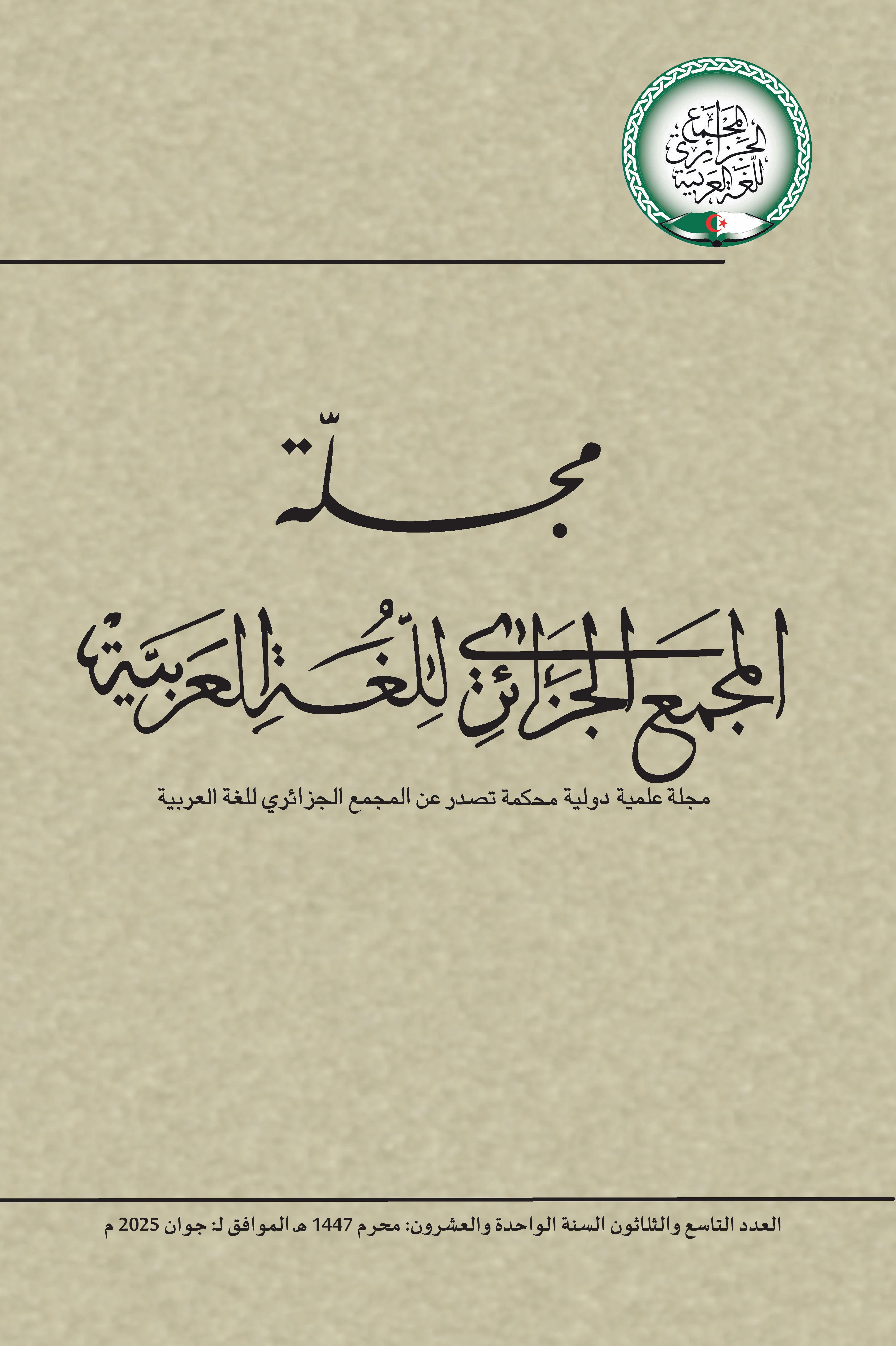أهمية التحليل الفيزيائي في دراسة الظواهر اللغوية التفخيم والحركات الطويلة في اللغة العربية أنموذجا
DOI:
https://doi.org/10.70443/jaaal.v21i1.301الكلمات المفتاحية:
التحليل الفيزيائي، الظّاهرة اللّغويّة، الصوتيات العربية، الصوائت العربية، الحروف المفخمةالملخص
يوفّر التحليل الفيزيائي رؤى موضوعية حول إنتاج الكلام من خلال قياس المعايير الصوتية الرئيسية. في اللسانيات العربية، يمكّن هذا التحليل من دراسة دقيقة للسمات الصوتية مثل التفخيم والصوائت العربية، وهي سمات يصعب تقييمها من خلال التحليل السمعي وحده. يستعرض هذا المقال التطور التاريخي للتحليل الفيزيائي، وخصائصه الأساسية، وتطبيقاته في تعلم اللغة، وعلاج النطق، والبحث اللساني. تسلط النتائج الضوء على دور هذه الطريقة في تحسين تدريب النطق، وتشخيص اضطرابات الكلام، وتطوير الدراسات في الصوتيات العربية من خلال أدوات مدعومة بالذكاء الاصطناعي والتعاون المتعدد التخصصات.
التنزيلات
المراجع
Al-Ani, S. H. (1970). Arabic phonology: An acoustical and physiological investigation. Mouton. DOI: https://doi.org/10.1515/9783110878769
Alotaibi, Y., & Hussain, M. (2016). Acoustic characteristics of Arabic vowels: A comparative study of Modern Standard Arabic and Qassimi dialect. Journal of the Acoustical Society of America, 139(1), 310–325. https://doi.org/10.1121/1.4939894 DOI: https://doi.org/10.1121/1.4939894
Al-Tamimi, J., & Khattab, G. (2018). Articulatory and acoustic correlates of pharyngealization in Arabic. Journal of Phonetics, 71, 306–325. https://doi.org/10.1016/j.wocn.2018.09.008 DOI: https://doi.org/10.1016/j.wocn.2018.09.010
Boersma, P., & Weenink, D. (2023). Praat: Doing phonetics by computer (Version 6.3) [Computer software]. https://www.praat.org
Boula de Mareüil, P., & Zeroual, I. (2015). An acoustic study of emphasis in Moroccan and Algerian Arabic. Proceedings of the 18th International Congress of Phonetic Sciences, Glasgow. https://www.internationalphoneticassociation.org/icphs-proceedings/ICPhS2015/Papers/ICPHS0386.pdf
Domahs, U., Knaus, J. A., El Shanawany, H., & Wiese, R. (2014). The role of predictability and structure in word stress processing: An ERP study on Cairene Arabic and a cross-linguistic comparison. Frontiers in Psychology, 5, 1151. https://doi.org/10.3389/fpsyg.2014.01151 DOI: https://doi.org/10.3389/fpsyg.2014.01151
Duffy, J. R. (2020). Motor speech disorders: Substrates, differential diagnosis, and management (4th ed.). Elsevier.
Embarki, M. (2013). Acoustic correlates of emphasis in Arabic: Evidence from four dialects. Journal of Semitic Studies, 58(1), 135–160. https://doi.org/10.1093/jss/fgs042 DOI: https://doi.org/10.1093/jss/fgs042
Fant, G. (1960). Acoustic theory of speech production. Mouton.
Ferrat, K. (2024). The acoustic analysis of Arabic emphatic consonants using the Praat computer software. Algerian Academy of Arabic Language Journal, 20(1), 43–68. DOI: https://doi.org/10.70443/jaaal.v20i1.284
Ferrat, K. (2009). Analyse acoustique et évaluation de la rééducation de la maladie de Parkinson dans le milieu hospitalier algérien. Revue Al Lisaniyyat, 14–15, 59–78. DOI: https://doi.org/10.61850/allj.v14i2.419
Ferrat, K., & Guerti, M. (2012). A study of sounds produced by Algerian esophageal speaker. African Health Sciences, 4, 452–458. http://dx.doi.org/10.4314/ahs.v12i4.9 DOI: https://doi.org/10.4314/ahs.v12i4.9
Fouz-González, J. (2019). Using apps for pronunciation training: An empirical evaluation of the English File Pronunciation app. Language Learning & Technology, 23(1), 67–85. https://doi.org/10125/44664
Grabowski, E. (2023). Methodological trends in acoustic phonetic analysis. Proceedings of the 20th International Congress of Phonetic Sciences, ICPhS 2023, 984–988.
Heselwood, B. (2023). Pharyngeal articulations in Semitic languages. In Pharyngeal articulations in Semitic languages (pp. 112–167). Oxford University Press.
Khattab, G., & Al-Tamimi, J. (2013). Emphasis and vowel quality in Jordanian Arabic: An acoustic and articulatory study. Journal of Phonetics, 41(3), 163–173. https://doi.org/10.1016/j.wocn.2013.01.002 DOI: https://doi.org/10.1016/j.wocn.2013.01.002
Kent, R. D., & Kim, Y. J. (2003). Toward an acoustic typology of motor speech disorders. Clinical Linguistics & Phonetics, 17(6), 427–445. https://doi.org/10.1080/0269920031000086248 DOI: https://doi.org/10.1080/0269920031000086248
Ladefoged, P., & Johnson, K. (2014). A course in phonetics (7th ed.). Cengage.
Mitrofanova, O., & Tuller, L. (2021). Acoustic markers of vowel quality in Maghrebi Arabic dialects. Phonetica, 78(3), 231–260. https://doi.org/10.1159/000509875 DOI: https://doi.org/10.1159/000509875
Zawaydeh, B. A. (1999). The phonetics and phonology of gutturals in Arabic. Indiana University Linguistics Club Publications.
Zawaydeh, B., & de Jong, K. (2021). Arabic phonetics and phonology. De Gruyter.
Zeroual, I., Boula de Mareüil, P., Barkat-Defradas, M., Maamouri, H., & Belkessam, A. (2021). Emphasis production in Arabic-speaking children with dysarthria. International Journal of Language & Communication Disorders, 56(3), 567–581. https://doi.org/10.1111/1460-6984.12612 DOI: https://doi.org/10.1111/1460-6984.12612
التنزيلات
منشور
إصدار
القسم
الرخصة
الحقوق الفكرية (c) 2025 المؤلفون

هذا العمل مرخص بموجب Creative Commons Attribution-NonCommercial 4.0 International License.













 مجلة المجمع الجزائري للغة العربية تصدر عن
مجلة المجمع الجزائري للغة العربية تصدر عن